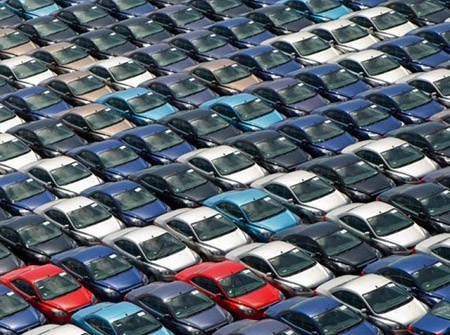Private buyers returned to the new car market in Hungary
 By the end of February, 9967 new passenger cars were released in Hungary, 24.5 percent more than a year earlier. According to Hungarian Association of Vehicle Importers (MGE), the trend shows that the positive outlook is realistic for the whole year. Private buyers returned to 40%, though corporate purchases (especially 1-3 cars) can be considered as private purchases. Placing pure-electric cars is growing significantly but still in small quantities. The 1.5 million HUF purchasing subsidies, the gradual expansion of charging infrastructure and other benefits support the positive trend in the sale of pure electric cars. The decline in the small-car market has stopped and marked a rise, but is behind the forecast at the end of the second month. They still consider it necessary and advocate the revival of a mixed-use small-cargo vehicle category. This category would largely support small and medium-sized businesses, which is the stated purpose of government. The trend for a small trucks also underpins the projected growth. The growth of the market continues with big-size vehicles, which depends to a great extent on the fleet’s purchases of the major freight forwarders and the monthly transfers. The market is hits the projected growth. Due to the very small size of the bus market, it is possible to show significant monthly differences, but it is important to see an annual increase since the Hungarian bus park is very old and needs to be replaced. Currently, the growth rate exceeds the predicted.
By the end of February, 9967 new passenger cars were released in Hungary, 24.5 percent more than a year earlier. According to Hungarian Association of Vehicle Importers (MGE), the trend shows that the positive outlook is realistic for the whole year. Private buyers returned to 40%, though corporate purchases (especially 1-3 cars) can be considered as private purchases. Placing pure-electric cars is growing significantly but still in small quantities. The 1.5 million HUF purchasing subsidies, the gradual expansion of charging infrastructure and other benefits support the positive trend in the sale of pure electric cars. The decline in the small-car market has stopped and marked a rise, but is behind the forecast at the end of the second month. They still consider it necessary and advocate the revival of a mixed-use small-cargo vehicle category. This category would largely support small and medium-sized businesses, which is the stated purpose of government. The trend for a small trucks also underpins the projected growth. The growth of the market continues with big-size vehicles, which depends to a great extent on the fleet’s purchases of the major freight forwarders and the monthly transfers. The market is hits the projected growth. Due to the very small size of the bus market, it is possible to show significant monthly differences, but it is important to see an annual increase since the Hungarian bus park is very old and needs to be replaced. Currently, the growth rate exceeds the predicted.
Source: www.mge.hu

Global car market growing
In 2017 the number of new cars sold was over 90 million for the first time, according to the WardsAuto. Growth in sales is mainly due to the expansion of Asian purchases, and in particular to the growth of Chinese market, said the leading US magazine. Approximately 25 percent of the cars was sold in China. Continous expansion of sales in Western Europe has also contributed to the growth, while demand of the emerging countries such as Russia and Brazil, started to rise again. The number of cars sold last year was 2.7 percent higher than a year earlier an it has risen 4.1 percent on average since 2009, while the population of the Earth – according to the World Bank data – was growing at a slightly lower rate by 1.2 percent.
Sources: www.mti.hu, www.wardsAuto.com, www.globalfleet.com
Polish e-mobility program
 One million electric vehicles to be expected in Poland within ten years, due to the new E-Mobility Law passed last month. Observers notice that only 427 new electric vehicles were sold in Poland last year and 150,000 in the EU in 2015. The penetration will be encouraged by tax allowance and other benefits for indivudulas and institutional buyers as well. For this law to be a success, charging stations will need to be built across the country, in particular along main transit routes. These charging stations will need to accept any type of electric vehicle on the market in Europe. According to figures of the Polish Ministry of Energy, there are only around 300 charging stations in the country at this moment.
One million electric vehicles to be expected in Poland within ten years, due to the new E-Mobility Law passed last month. Observers notice that only 427 new electric vehicles were sold in Poland last year and 150,000 in the EU in 2015. The penetration will be encouraged by tax allowance and other benefits for indivudulas and institutional buyers as well. For this law to be a success, charging stations will need to be built across the country, in particular along main transit routes. These charging stations will need to accept any type of electric vehicle on the market in Europe. According to figures of the Polish Ministry of Energy, there are only around 300 charging stations in the country at this moment.
Now 90 percent of electric vehicle parts are manufacturing in Poland. LG Chem intends to build a lithium-ion battery plant near Wroclaw in 2018, announced earlier. The factory, largest electric vehicle battery factory for Europe, will be scaled to produce enough cells for 100,000 battery packs. The factory will employ 2,500 people. In addition, e-mobility in Poland comprises the e-car sharing, mainly in Warsaw and Krakow, where a fleet of 200 cars is set up. Similar plans are formed in other Polish cities. In public transport, the potential for propulsion of electric drives seems even more favorable. The Minister of Energy claims that one million electric cars will need 4 terawatt hours of energy annually, which will drive 2 billion zlotys on sales to the electricity traders, and bus and coach manufacturers will expect a surplus of 2.5 billion zlotys annually from the renewal of public transport.
Sources: www.fleeteurope.com, www.energiainfo.hu, www.mti.hu

